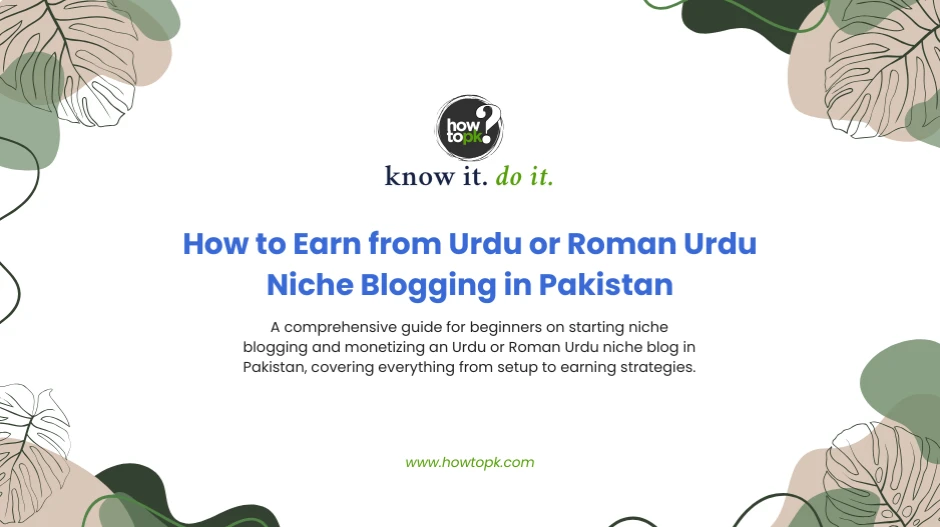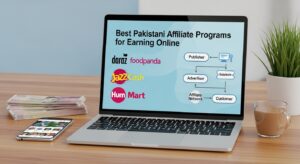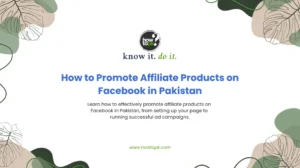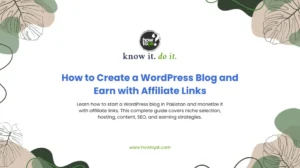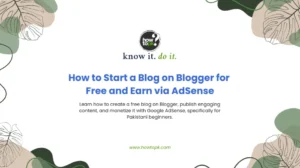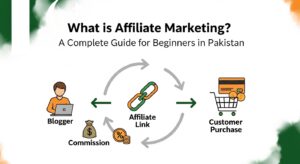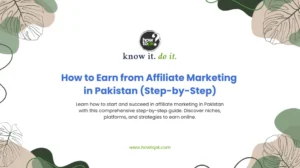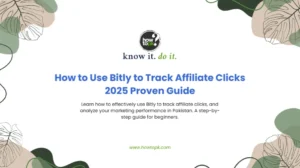Niche blogging has emerged as a powerful way to share ideas, build communities, and, importantly, earn an income in Pakistan. With a vast population that increasingly accesses the internet, especially on mobile devices, there’s a significant and growing demand for local language content. This guide will walk you through every step of starting and monetizing a niche blog in Urdu or Roman Urdu, specifically tailored for the Pakistani audience.
Whether you’re a student, a stay-at-home parent, or someone looking for a side income, this comprehensive resource will provide you with the knowledge and practical advice to turn your passion into profit. Let’s explore how to create a successful blog that truly resonates with Pakistanis.
Understanding the Opportunity: Why Urdu & Roman Urdu Niche Blogging?
Before diving into the “how-to,” it’s crucial to grasp the immense potential of blogging in local languages within Pakistan. Many internet users in Pakistan prefer consuming content in their native language, Urdu, or its transliterated form, Roman Urdu. This preference creates a unique, underserved market waiting for quality content.
What is Roman Urdu?
Roman Urdu is essentially Urdu written using the Latin script, similar to how you would type English. It’s widely used in informal communication on social media, messaging apps, and sometimes even in online articles, as it’s easier for many to type and read without needing an Urdu keyboard.
Why Focus on a Niche?
A niche is a specific, well-defined topic area. Instead of writing about “everything,” you focus on a particular subject, like “Pakistani cooking recipes,” “local travel destinations,” “budgeting tips for Pakistani families,” or “reviews of local tech gadgets.”
Focusing on a niche helps you attract a dedicated audience, establish yourself as an authority, and compete more effectively in search engine rankings. It also makes content creation much more manageable and targeted.
Step 1: Discover Your Niche and Passion
The foundation of any successful blog is a well-chosen niche. This isn’t just about what’s popular; it’s about what you are genuinely passionate about and knowledgeable in.
- Are you great at cooking traditional Pakistani dishes? (Niche: Pakistani recipes)
- Do you know all the best places to visit in Northern Areas on a budget? (Niche: Budget travel Pakistan)
- Are you skilled in repairing common household appliances? (Niche: DIY home repairs Pakistan)
- Do you understand personal finance and investing in the local context? (Niche: Personal finance for Pakistanis)
Once you have a few ideas, do a quick search on Google (in both Urdu and Roman Urdu) to see what kind of content already exists. Look for gaps or areas where you can provide more detailed, localized, or unique perspectives.
Common Mistakes and Tips:
Don’t choose a niche that’s too broad (like “news”) or too narrow (like “the history of a single Lahore landmark”). Aim for a balance where you can consistently generate new content ideas but still attract a specific audience.
Step 2: Choose Your Blogging Platform
The platform you use will determine how easy it is to set up, manage, and scale your blog. For beginners, a user-friendly and feature-rich option is essential.
A widely recommended platform for blogging is a particular open-source content management system. It’s free to use, highly customizable with countless themes and plugins, and search engine friendly. While the platform itself is free, you’ll need to pay for a domain name and web hosting.
Alternatively, there are hosted blogging services that allow you to start a blog for free, but they often come with limitations on customization, monetization, and might not allow you to use your own domain name initially. For serious long-term blogging, the self-hosted option is generally preferred.
Step 3: Register Your Domain Name and Get Web Hosting
Your domain name is your blog’s address on the internet (e.g., https://www.google.com/search?q=yourblogname.com.pk), and web hosting is where your blog’s files are stored.
Domain Name:
Think of a few relevant names. You can use English, Roman Urdu, or even an Urdu word transliterated into English. For a Pakistani audience, a .pk domain extension can be beneficial for local SEO, but a .com or .net is also perfectly fine and globally recognized. Check for availability through domain registrars. Keep it short, easy to spell, and pronounce.
Web Hosting:
Many local and international web hosting providers offer services in Pakistan. Look for hosts that offer good uptime (how often your site is online), fast loading speeds, good customer support, and reasonable prices. Shared hosting is usually sufficient for beginners. Ensure they support the content management system you chose (e.g., popular content management system hosting).
Once you’ve purchased your domain and hosting, you’ll connect them. Your hosting provider will give you nameserver details, which you’ll update in your domain registrar’s settings. This process usually takes a few hours to a day to propagate.
Common Mistakes and Tips:
Avoid domain names that are too long, difficult to remember, or contain hyphens unnecessarily. For hosting, don’t just go for the cheapest option; reliability and support are more important in the long run.
Step 4: Set Up Your Blog and Design
This is where your blog starts to take shape visually and functionally.
Installation: Most web hosting providers offer a “one-click install” feature for popular content management systems, making the process straightforward. Follow their instructions to install it on your domain.
Theme Selection: Choose a clean, responsive theme that is mobile-friendly. Many free and premium themes are available. Look for themes that support right-to-left (RTL) text if you plan to write purely in Urdu script, or themes that display Roman Urdu clearly. Prioritize readability.
Basic Settings:
- Permalinks: Set your permalink structure to “Post name” (e.g., yourblog.com/your-post-title) for better SEO.
- Site Title & Tagline: Give your blog a clear title and a tagline that describes what it’s about.
- Reading Settings: Decide whether your homepage displays your latest posts or a static page.
- Time Zone: Set your time zone to Pakistan Standard Time (PKT).
Consider adding essential pages like an “About Us” page (telling your story), a “Contact Us” page, and a “Privacy Policy” (important for monetization later). These build trust and are often required by advertising networks.
Step 5: Create High-Quality Content in Urdu or Roman Urdu
Content is king, especially in niche blogging. Your articles need to be engaging, informative, and relevant to your Pakistani audience.
Content Planning: Based on your niche, brainstorm topics and create a content calendar. Think about keywords your target audience might use when searching for information in Urdu or Roman Urdu. Use a mix of evergreen content (always relevant) and trending topics.
Writing Style:
- For Urdu Script: Write clear, grammatically correct Urdu. If you’re comfortable with Urdu typography, this can be very appealing to readers who prefer the script.
- For Roman Urdu: Be consistent with your transliteration style. Avoid overly informal or slang terms unless it’s appropriate for your niche and target audience. Roman Urdu is often used for ease of typing, so focus on clarity.
Localization: Incorporate local examples, cultural references, and everyday experiences that resonate with Pakistanis. For instance, if you’re writing a cooking blog, mention locally available ingredients or traditional cooking methods.
Structure: Break down your content into short paragraphs (max 3 lines), use headings (H2, H3), and bullet points to improve readability. This is especially important for mobile users, who form a large segment of Pakistan’s internet population.
SEO Best Practices (Urdu/Roman Urdu):
- Keyword Research: Think about how Pakistanis search. Do they use specific Urdu phrases? Are they more likely to type in Roman Urdu? Use tools to find relevant keywords in both languages.
- On-Page SEO: Include your primary keywords in your article title, headings, introduction, and throughout the body naturally.
- Image Optimization: Use relevant images and optimize them with descriptive alt text, ideally in Urdu or Roman Urdu.
- Internal Linking: Link to other relevant articles on your blog to keep readers engaged and improve your site’s SEO.
Originality: Always write original content. Do not copy from other sources. Your unique voice and perspective are your biggest assets.
Step 6: Drive Traffic to Your Blog
Even the best content needs to be seen. You need strategies to bring readers to your blog.
- Search Engine Optimization (SEO): This is arguably the most crucial long-term strategy. Focus on creating quality content that naturally incorporates keywords. Build relevant backlinks to your site from other reputable Pakistani websites or blogs. Ensure your site loads fast and is mobile-friendly.
- Social Media Marketing: Share your blog posts on popular social media platforms in Pakistan, such as Facebook, Instagram, and YouTube. Create engaging snippets or questions to draw people in. Use relevant Urdu or Roman Urdu hashtags.
- Community Engagement: Participate in online forums, Facebook groups, or discussion platforms where your target audience hangs out. Share your insights and link back to your blog posts when relevant and allowed. This builds your reputation and drives referral traffic.
- Guest Blogging: Write articles for other popular Pakistani blogs in your niche. This exposes your blog to a new audience and provides valuable backlinks.
- Email List Building: Offer something valuable (like a free guide or checklist) in exchange for email addresses. An email list allows you to directly communicate with your audience and notify them about new posts.
Common Mistakes and Tips:
Don’t just post and forget. Actively promote your content. Don’t spam social media or forums; provide value first. Be patient; building traffic takes time and consistent effort.
Step 7: Monetize Your Urdu/Roman Urdu Blog
This is where your efforts translate into income. Several methods are suitable for blogs targeting the Pakistani audience.
1. Google AdSense:
This is one of the most common ways to monetize a blog. AdSense displays relevant ads on your blog, and you earn money when visitors view or click on them. Google AdSense supports Urdu, making it a viable option for Urdu and Roman Urdu blogs.
- How to apply: You’ll need to sign up for an AdSense account. Ensure your blog complies with AdSense program policies (e.g., no inappropriate content, sufficient original content). Place the AdSense code on your blog, and Google’s AI will automatically serve ads.
- Tips: Focus on getting more traffic. The more visitors you have, the higher your potential earnings. Don’t click on your own ads, as this can lead to account suspension.
2. Affiliate Marketing:
You promote products or services on your blog and earn a commission when someone makes a purchase through your unique affiliate link.
- How to do it: Join affiliate programs relevant to your niche. For instance, if you blog about tech gadgets, you can join affiliate programs of local e-commerce stores. Share product reviews, comparisons, or guides and naturally embed your affiliate links.
- Local opportunities: Look for affiliate programs offered by popular Pakistani e-commerce platforms or local brands. Also, consider global programs if the products are relevant to Pakistan and accessible.
- Tips: Only promote products you genuinely believe in. Transparency is key; always disclose that you are using affiliate links.
3. Sponsored Content / Collaborations:
As your blog gains authority, brands might approach you to publish sponsored posts, reviews, or integrate their products into your content. This is essentially paid promotion.
- How to do it: Build a strong reputation and audience. Create a “Work With Me” page on your blog detailing your audience demographics and services. Directly approach brands that align with your niche.
- Tips: Set clear rates for your services. Ensure the sponsored content feels natural and relevant to your audience, maintaining your blog’s authenticity.
4. Selling Your Own Products or Services:
This is often the most lucrative monetization method. You can create and sell digital products (e-books, online courses, templates) or offer services (consulting, freelance writing, coaching) directly through your blog.
- Examples for Pakistan:
- If you blog about cooking, sell your own recipe e-book (in Urdu or Roman Urdu).
- If you blog about personal finance, offer one-on-one consulting sessions.
- If you blog about local travel, create a detailed travel guide e-book for a specific region.
- Payment gateways in Pakistan: For selling directly, you’ll need local payment solutions like Easypaisa, JazzCash, or bank transfers. For credit/debit card payments, you might explore local payment gateways that integrate with your website.
- Tips: Identify a real need or problem that your product/service solves for your audience. Start small and iterate based on feedback.
5. Direct Advertisements:
Instead of relying on AdSense, you can directly sell ad space on your blog to businesses. This often results in higher earnings if you have substantial, targeted traffic.
- How to do it: Create a media kit that outlines your blog’s statistics, audience demographics, and advertising rates. Contact local businesses relevant to your niche.
- Tips: This works best for blogs with established traffic and a clear target audience.
Common Mistakes and Challenges:
Don’t try to monetize too early if your traffic is low; focus on building an audience first. Don’t overcrowd your blog with too many ads, as this can deter readers. Payment processing can be a challenge in Pakistan, so research reliable local options thoroughly.
Step 8: Promote Your Blog for Consistent Growth
Blogging is an ongoing process. Once your blog is set up and you’re creating content, you need to continually promote it.
- Maintain Social Media Presence: Regularly share your new and old content on platforms popular in Pakistan. Engage with your followers, respond to comments, and participate in relevant discussions. Consider running occasional paid promotions on social media to reach a wider audience in Pakistan.
- Email Marketing: Send out newsletters with your latest posts, exclusive content, or special offers. This keeps your audience engaged and brings them back to your blog.
- Update Old Content: Regularly review and update your older blog posts to keep them fresh and relevant. This also helps with SEO. Add new information, images, or examples.
- Analyze Performance: Use analytics tools to understand your audience: what content they like, how they find you, and how long they stay. This data helps you refine your content strategy.
- Network with Other Bloggers: Connect with other Pakistani bloggers in your niche. Collaborate on projects, cross-promote each other’s content, or even co-host events.
Step 9: Legal and Financial Considerations in Pakistan
As you start earning, it’s important to understand the legal and financial aspects in Pakistan.
- Taxation: For small-scale earnings, you might initially operate as an individual. As your income grows, it’s advisable to consult with a tax advisor in Pakistan to understand your obligations regarding income tax. Online earning is subject to taxation, so proper record-keeping is essential.
- Business Registration: If your blog grows into a substantial business, you might consider registering it as a sole proprietorship or a similar legal entity. This can offer benefits for banking and formalizing operations.
- Payment Receipts: Keep proper records of all your earnings, whether from AdSense, affiliate commissions, or direct sales. This will be helpful for tracking your financial progress and for tax purposes.
Common Mistakes and Tips:
Don’t ignore financial planning. Start keeping records from day one. While not strictly “legal,” be mindful of cultural sensitivities and local norms in your content to avoid any issues.
Conclusion
Earning from Urdu or Roman Urdu niche blogging in Pakistan is a realistic and rewarding endeavor. It requires patience, consistent effort, and a genuine desire to provide value to your audience. By following these steps, from discovering your passion and setting up your blog to creating compelling content and diversifying your monetization strategies, you can build a successful online presence that resonates deeply with the Pakistani community.
Remember, the journey of a thousand miles begins with a single step. Start small, learn continuously, adapt to your audience’s needs, and enjoy the process of sharing your voice with the world, one post at a time.
Resources
Monetization & Advertising
- Google AdSense – Industry-leading ad network to monetize your blog content with display ads.
Content Management Systems
- WordPress – The most popular and flexible CMS for building and managing blogs.
Domain Registrars
- PKNIC – For registering
.pkdomain names in Pakistan. - GoDaddy – Global registrar for
.com,.net, and other TLDs. - Namecheap – Affordable domain names and free WHOIS privacy protection.
Web Hosting Providers
- Hostinger – Fast, affordable global hosting with good support.
- Navicosoft – Pakistani hosting provider offering localized plans.
- HosterPK – Local hosting service for Pakistani bloggers and businesses.
Social Media Platforms
Affiliate Marketing Platforms
- Daraz Affiliate Program – Promote local products with payouts in PKR.
- Amazon Associates – Earn commissions from international product referrals.
- Fiverr Affiliate Program – Promote freelance services and earn per referral.
Email Marketing Services
- Mailchimp
- ConvertKit – Build and engage an email list to increase blog traffic and earnings.
Local Payment Solutions
- Easypaisa
- JazzCash – Both ideal for receiving local payments or affiliate earnings.
- Direct bank transfers via local banks.
- Integration with local payment gateways for product or service sales.
Analytics & Performance Tracking
- Google Analytics – Monitor your blog’s traffic, user behavior, and performance.

